
Barry Town United Football Club is a semi-professional association football team based in Barry, Wales. They are known for representing Wales in Europe as winners of the Cymru Premier and Welsh Cup during the 1990s and early 2000s and have also competed in England's Southern League and FA Cup. The team, which has contained more than 50 full internationals, is now run by supporters. They play at their traditional home of Jenner Park, Barry, which holds 3,500 spectators.

Dens Park, officially known as Scot Foam Stadium for sponsorship reasons, is a football stadium in Dundee, Scotland, which is the home of Scottish Premiership club Dundee F.C. and has a capacity of 11,775. Tannadice Park, the home of rivals Dundee United, is just 200 yards away.

East End Park, currently named KDM Group East End Park for sponsorship purposes, is a football stadium situated in Dunfermline, Fife, Scotland with a seating capacity of 11,480.
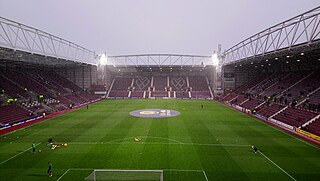
Tynecastle Park, also known as Tynecastle Stadium, is a football stadium in the Gorgie area of Edinburgh, which is the home ground of Scottish Professional Football League club Heart of Midlothian (Hearts). A UEFA category four stadium, it has also hosted Scotland international matches, and been used as a neutral venue for Scottish Cup and Scottish League Cup semi-finals.

Ninian Park was a football stadium in the Leckwith area of Cardiff, Wales, that was the home of Cardiff City F.C. for 99 years. Opened in 1910 with a single wooden stand, it underwent numerous renovations during its lifespan and hosted fixtures with over 60,000 spectators in attendance. At the time of its closure in 2009, it had a capacity of 21,508.
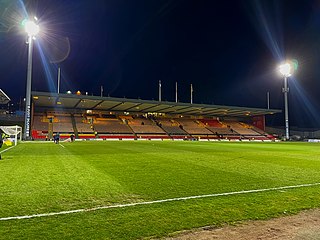
Firhill Stadium, also known as Wyre Stadium at Firhill for sponsorship reasons, is a football and former rugby union, rugby league and greyhound racing stadium located in the Maryhill area of Glasgow, Scotland which has been the home of Partick Thistle since 1909.

Vale Park is a football stadium in Stoke-on-Trent, England. It has been the home ground of Port Vale F.C. since 1950.
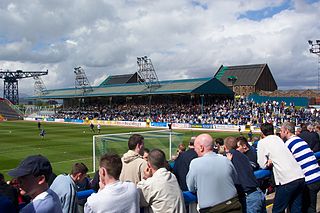
Cappielow, also known as Cappielow Park supported by Dalrada Technology UK for sponsorship reasons, is a football stadium in Greenock, Inverclyde, Scotland. It is the home ground of Scottish Professional Football League club Greenock Morton, who have played there since 1879. It has a capacity of 11,589, including 5,741 seats. The ground was formerly also shared by Clydebank between 1999 and 2002. Cappielow has staged one full international match, Scotland against Wales in 1902.
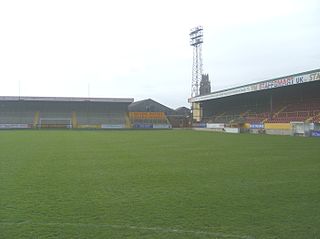
York Street, also known as The Jakemans Stadium for sponsorship purposes, is a football stadium in Boston, England, and was the former home of Boston United. Originally called Shodfriars Lane, football was first played on the site since the late 19th century by a variety of Boston teams, but it was only used by Boston United since 1933. In the late 1970s the ground was rebuilt. Although the ground currently had a maximum capacity of 6,643, the record crowd was 11,000 against Derby County. 10 further attendances of more than 8,000 are on record. Boston United left the York Street ground at the end of the 2019/20 season. In August 2021 Railway Athletic FC moved into the stadium.
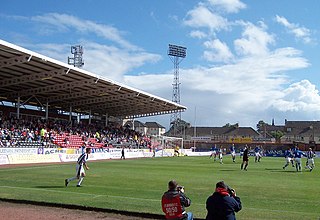
St Mirren Park, more commonly known as Love Street, was a football stadium located on Love Street in Paisley, Scotland. At one time the stadium was capable of accommodating almost 50,000 spectators, however in its final years it had an all-seated capacity of 10,800. Until its closure in 2009, it was the home ground of St Mirren F.C.

Stebonheath Park is a multi-use stadium in Llanelli, West Wales with a capacity of 3,700. It is primarily used as a football ground and is the home of Llanelli Town A.F.C. It was also used for athletics and Llanelli Amateur Athletic Club were based at the stadium. It is owned by Llanelli Town Council. From 2015 West Wales Raiders rugby league club used the stadium for their debut season in the Conference League South and subsequent season in the RFL League 1 until the club withdrew from the league in December 2022.
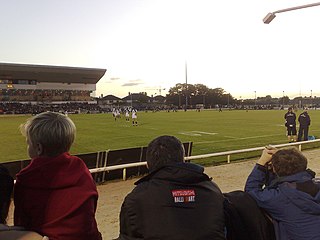
The Sportsground, also known as The Galway Sportsgrounds and the Galway Greyhound Stadium and the Connacht Rugby Stadium is a multi-purpose stadium in Galway, Ireland. It opened in 1927, with the playing of a football match and has been used to host Connacht Rugby matches and greyhound racing since that time.

Cliftonhill Stadium, commonly known as Cliftonhill and currently 'The Reigart Stadium' for sponsorship purposes, is a football stadium in Coatbridge, North Lanarkshire, Scotland. It is the home ground of Scottish Professional Football League team Albion Rovers F.C., who have played at the ground since 1919.

A floodlight is a broad-beamed, high-intensity artificial light. They are often used to illuminate outdoor playing fields while an outdoor sports event is being held during low-light conditions. More focused kinds are often used as a stage lighting instrument in live performances such as concerts and plays.

Central Park is a multi-use stadium in Cowdenbeath, Fife, Scotland, used for football and stock car racing. It is situated in the centre of the town, just off the High Street, and has a capacity of 4,309. The pitch size is 107 x 66 yards. Central Park has been the home ground of Lowland League team Cowdenbeath F.C. since it opened in 1917. Stock car racing has taken place at the ground since 1970, and takes place on a tarmac racetrack surrounding the football pitch. Central Park was also previously a venue for greyhound racing between 1928 and 1965.
Boghead Park was a football ground in the town of Dumbarton, Scotland. It was owned by Dumbarton F.C., who played there for 121 years between 1879 and 2000. By the time the ground closed in 2000, it was the oldest stadium in Scotland that had been in continuous use.
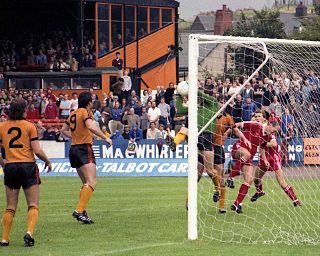
Somerton Park was a football, greyhound racing and speedway stadium in Newport, South Wales.
Cressing Road, also known as the Rare Breed Meat Co. Stadium for sponsorship purposes, is a football stadium in Braintree, Essex, and the home ground of Braintree Town, and formally their reserve side. It currently has a capacity of 4,222.
Volunteer Park is a football ground in Armadale, West Lothian, Scotland. It is the home ground of Armadale Thistle, and was used by several of the town's previous clubs, including Armadale F.C., who played Scottish Football League matches there between 1921 and 1933. The ground also hosted greyhound racing during the 1930s.

The National Stadium was a rugby union and football stadium built on the Cardiff Arms Park site in Cardiff, Wales. In 1969 construction began on the stadium which replaced the existing rugby ground built in 1881. The stadium was home to the Wales national rugby union team since 1964 and the Wales national football team since 1989. In 1997 the stadium was demolished to make way for the new Millennium Stadium.



















